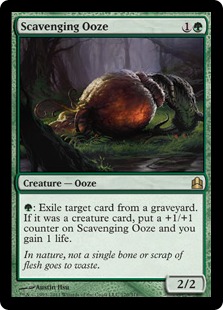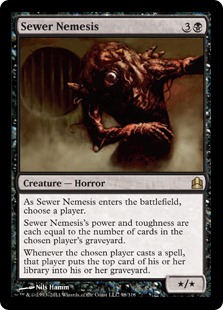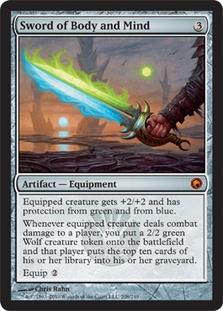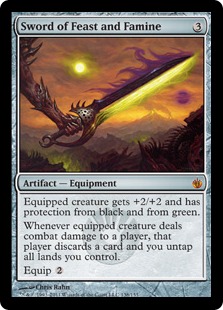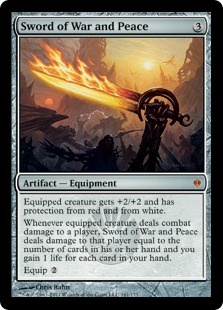As a collection of the best cards in the game, it can be difficult to make room for newly discovered or newly released cards in a cube. Recognizing the
power of cards to put into a cube is one thing, but because of the limited number of slots in a cube, I find that the harder part is considering what
cards need to be taken out to make room for new cards if they’re good enough for your cube.
But how do you determine which ones should be cut? There are a few ways to determine that.
The first types are underpowered and suboptimal cards that aren’t pulling their weight anymore. As obvious as “cut underpowered
cards” may sound, it isn’t as easy to find these cards as you may think.
Cards are generally included in cubes because they hold the promise of doing something well (the question of whether they live up to that
promise is another question.) No one ever thinks “This card looks like it’s going to be a marginally better Hill Giant. Get in my cube
now!” after all. Cards that don’t live up to their intentions and perform sub-optimally are the easiest ones to weed out of a cube and they
don’t tend to last very long. At least in theory. In reality, evaluating the power level of cards in a cube isn’t as easy because if that
was the case, maintaining a cube wouldn’t be terribly difficult.
How do you find out which cards aren’t pulling their weight when considering something else to take its place?
For example, let’s look at Scavenging Ooze from Commander.
One of the ways that I use to evaluate cards is to look at other similar cards in mana cost.
For something like the Ooze, I’d look at the other cube-worthy two-drops in green as it’ll usually be a solid creature in aggressive decks
(as it’ll be able to provide some reach) and midrange decks alike.
When looking at other cards of the same mana cost, it’s important to look at all of the cards that you’re using at that cost. Not every
two-drop is going to be a Tarmogoyf, after all. Still, it can be hard to evaluate the overall power level of a cost in a cube. How does Scavenging Ooze
compare to Wall of Blossoms? Rofellos, Llanowar Emissary? Wall of Roots? Albino Troll? As all of these cards perform different tasks, it can be
difficult to compare them and what amongst them should be cut.
Still, this is a useful exercise because if it results in finding something that sticks out as weaker than the others (like Sylvan Ranger when compared
to the aforementioned creatures). Comparing cards to similar ones at the same cost can help make these discoveries easier to see.
Another way is to outsource the evaluation onto your drafters by looking at the percentage of the time that a card spends in the maindeck and
sideboard. This uses the percentage of time that a card spends in the maindeck as a barometer for how well a card was performing in a cube.
As a fan of statistics, I had an Excel sheet with all of the cards in my cube featuring the percentage of time that the card was maindecked and the
percentage of the time that it spent in the sideboard. I don’t use this method anymore as I simply don’t have the time to enter the data
into the spreadsheet, but I instead use a more subjective method of looking at how often a card goes into a maindeck versus the amount of times that a
card goes into the sideboard, keeping mental note of cards that are frequently in the sideboard. However, it’s important to note that this method
isn’t perfect and despite the fact that it can give useful information (after all, I wouldn’t have spent so much time on using it before if
it wasn’t worth my time), it’s important to know its limitations.
Some cards don’t get used sometimes because people underrate the card’s power. For a while, Survival of the Fittest wasn’t being used
in many decks because people initially underestimated the card’s power (“It doesn’t do anything!”). After the card
reached notoriety in Legacy, the people who thought that Survival of the Fittest wasn’t very good began to realize the card’s power.
Survival of the Fittest is an extremely powerful card in cube, arguably the strongest green card in the format. However, if I cut the card due to its
low maindeck-percentage use at the time, it’d have been a mistake. Other times, people may have had bad experiences with a card due to the cube
not supporting the card (like having a bad experience with Jungle Lion as those people may have drafted it in a cube with little aggro support) and
thus had it perform badly.
When you use this method, it’s important to get feedback from your drafters. If people think Jungle Lion is bad and you frequently see it in
sideboards, ask your drafters why they think that’s the case. Do they overvalue the fact that it can’t block as a drawback? Do
they think green aggressive strategies are weak? Some people argue that showing your doubtful opponents through action is a way to convince them (in
other words, if you beat them with Jungle Lion, they’ll see that it’s a good card) but this only really works if you cube with the same
playgroup multiple times.
Using outside perspectives
like getting advice from others who have cubes/have cube experience or getting another point of view from looking at other cube lists can be a useful
piece of advice on what to take out of a cube for newly discovered or printed cards. Due to their outside perspective, the others whose cubes or whose
advice that you take may not be as attached to the cards as you are.
For example, I considered Berserk to be a staple in my cube as I had it in my cube since day one and I figured that it’d be in my cube as long as
other staples like Lightning Bolt or Brainstorm. But when I saw other people take Berserk from out when considering Beast Within for their cubes, I
reconsidered its place as I went deep into the think tank on how its performance has been in my cube.
The conclusion that I came to was that it wasn’t performing as well as I had hoped, as it was a pretty mediocre combat trick. While its ability
to win games from out of nowhere and killing opposing attacking utility creatures like Dark Confidant or Looter il-Kor was useful, its overall effect
just wasn’t strong enough when put under the scrutiny of some critical evaluation. Beast Within seemed like a useful exchange.
Of course, you don’t want to join in a bandwagon and cut cards just because other people are. It’s important to be objective and
to consider the card’s overall effect, not just thinking about how the card performed in its best and worst cases, as these tend to be the
examples that stick out in our minds when we consider the card’s performance. But being truly objective is easier said than done.
Making upgrades usually happens when new cards come out and they obsolete older ones. When Burst Lightning was printed in
Zendikar, cube designers who were using Shock found an easy upgrade in Burst Lightning. The same happened with those who were using Blade of the Sixth
Pride when Accorder Paladin came out in Mirrodin Besieged. It’s arguable whether Shock or Blade of the Sixth Pride should still be used in cube
(as it depends on the size of the cube and the rarities allowed), making those initial upgrades is pretty easy.
This can also be applied to newly discovered or printed that perform a function better than an existing card, even if the replacement isn’t a
strict upgrade. The In Contention Podcast episode 33 1/3 went into detail on it, when
they talked about the Titans and how Sun Titan, Grave Titan and Inferno Titan were easy inclusions in cubes since those titans easily replaced similar
cards at the same cost. Cubes that used Skeletal Vampire could easily take that card out to include Grave Titan as, despite the fact that it
wasn’t a complete upgrade from Skeletal Vampire to Grave Titan, it was a huge upgrade nonetheless.
High-cost cards like the Titans are the best to directly replace since they (as well as other cards like mass-removal cards such as Rout and Wrath of
God) have their slots at a premium. Adding something like another finisher or another Wrath won’t have a catastrophic effect on a cube, but
it’s important to realize that, since decks that value them (mainly control decks) only use a few of them, there shouldn’t be too many in a
cube to ensure that control elements aren’t over-represented in a cube.
However, we can apply this point to other critical mana costs. Some cards may end up on the chopping block because they’re in a very
competitive mana slot, one of the most important being the four-drop slot. When thinking about Plague Sliver in my cube, I thought, “If they
printed 10 Juzam Djinns, I’d use all of them,” before quickly realizing that it’d be a terrible idea. I only have 61 cards in my
black section, so there just isn’t going to be enough space to use all of them. This analogy can be stretched a bit further with other four-drops
in cube as all of the colors have insane competition in the four-drop slot.
When I considered Sewer Nemesis for my cube, after some testing and consideration, I decided to not use the card because it couldn’t quite do
enough when compared to other four-drop creatures. Those other four-drops would be its competition and would be the main cards considered to cut for
Sewer Nemesis, and I felt that I was already at a critical level of four-drops in black. It’s a solid card, don’t get me wrong, but it
doesn’t quite do enough, at least, not as much as other cards like Plague Sliver/Juzam Djinn, Abyssal Persecutor and the other 187
creatures like Skinrender and Nekrataal.
If I had a larger cube with more black slots, I’d probably run it, but I just don’t have room for it right now, despite the fact that
it’s a good card. It’s just not better than what I am already using.
People have been considering cutting Loxodon Warhammer from their cubes lately for the same reason: the glut of three-mana equipment cards. There are a
lot of reasons why it was used in cubes and the Warhammer has a lot of positives going for it. It provides a huge power boost, and also gives lifelink
and evasion. Yet, I could honestly see cutting the card from smaller to midsized lists now that the Scars of Mirrodin block is over. Why?
With so many slots devoted to artifacts and equipment, there is only room for so many Equipment. Compared to the Swords and Grafted Wargear, Loxodon
Warhammer’s place in a smaller cube could be phased out because the other three-mana equipment performs better than the Warhammer.
This doesn’t necessarily mean that you have to cut cards of the same function for other cards of the same function like cutting two-drops for
two-drops or six-drops for six-drops. It is a good place to start when looking for cards to replace, but it’s not the be-all-end-all.
For example, when I put Sun Titan in my cube, I cut a two-drop (Blade of the Sixth Pride) because I felt that it was the weakest card in my cube and it
was worse than the other 2-drop creatures in my white section. Despite the fact that it was replacing cards with two different roles in cube (Blade
being an efficient attacker for aggressive decks, Sun Titan being a curve-topper for aggressive decks/general finisher for midrange and control decks),
the change was a positive one as the addition of Sun Titan didn’t skew things too much towards midrange and control and the power of Sun Titan
has made all white decks better.
I hope that this article has given you some pointers on how to find cards that can be cut for stronger, newly printed and discovered options
(especially as M12 is coming soon) for your cube. When Black Sun’s Zenith got printed in Mirrodin Besieged, I almost immediately knew that the
card could go into my cube, but it took me a lot longer to figure out what to take out. Hopefully this article will help you to make the difficult
process of finding cards to cut from your cube to be easier.
May all of your opening packs contain Sol Rings!
@UsmanTheRad
on Twitter
My blog featuring my (powered and pauper) cube lists: http://idratherbecubing.wordpress.com
Cube podcast that I and Anthony Avitolloco-host: The Third Power

